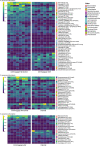Gut microbial communities of hybridising pygmy angelfishes reflect species boundaries
- PMID: 37202414
- PMCID: PMC10195815
- DOI: 10.1038/s42003-023-04919-7
Gut microbial communities of hybridising pygmy angelfishes reflect species boundaries
Abstract
Hybridisation and introgression of eukaryotic genomes can generate new species or subsume existing ones, with direct and indirect consequences for biodiversity. An understudied component of these evolutionary forces is their potentially rapid effect on host gut microbiomes, and whether these pliable microcosms may serve as early biological indicators of speciation. We address this hypothesis in a field study of angelfishes (genus Centropyge), which have one of the highest prevalence of hybridisation within coral reef fish. In our study region of the Eastern Indian Ocean, the parent fish species and their hybrids cohabit and display no differences in their diet, behaviour, and reproduction, often interbreeding in mixed harems. Despite this ecological overlap, we show that microbiomes of the parent species are significantly different from each other in form and function based on total community composition, supporting the division of parents into distinct species, despite the confounding effects of introgression acting to homogenize parent species identity at other molecular markers. The microbiome of hybrid individuals, on the other hand, are not significantly different to each of the parents, instead harbouring an intermediate community composition. These findings suggest that shifts in gut microbiomes may be an early indicator of speciation in hybridising species.
© 2023. Crown.
Conflict of interest statement
The authors declare no competing interests.
Figures





References
-
- Rhymer JM, Simberloff D. Extinction by hybridization and introgression. Annu. Rev. Ecol. Syst. 1996;27:83–109. doi: 10.1146/annurev.ecolsys.27.1.83. - DOI
Publication types
MeSH terms
LinkOut - more resources
Full Text Sources

